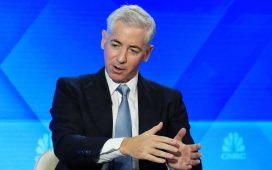Kathrin Ziegler | Digitalvision | Getty Images
ETF demand outstrips mutual funds
At a high level, ETFs are investment funds that generally hold a basket of many securities such as stocks and bonds, similar to mutual funds.
Unlike mutual funds, however, ETFs are traded on a stock exchange. Like stocks, they can be traded through the day and their share price rises and falls during that time. Mutual fund trades, by contrast, are executed once a day and all investors get the same price.
Investors pulled more than $900 billion from mutual funds in 2022 and funneled about $600 billion into ETFs, according to Morningstar. That net difference in dollar flows — about $1.5 trillion — was the largest on record.
“It was a huge, huge dispersion,” said Bryan Armour, director of passive strategies research for North America at Morningstar.
The last time mutual fund flows eclipsed those of ETFs was in 2013, he said.
“Overall, the trend has been toward ETFs and away from mutual funds,” Armour said.
ETFs’ growth has been global, too: Total assets outside the U.S. market were $2.7 trillion at the end of 2022, up fivefold in a decade, according to Morningstar data. Total global ETF assets may exceed $20 trillion by 2026, according to PwC.
Asset managers have tried to capitalize on this demand by debuting more funds. There were 419 U.S. ETF fund inceptions in 2022, versus 197 mutual funds, Morningstar found.
“We really started to see in the past 10 years an acceleration of both the demand of ETFs, and more recently with the supply of ETFs,” Rosenbluth said.
That said, ETFs have a ways to go before their total assets overtake those of mutual funds. Mutual funds hold about $17 trillion, for a roughly 70% market share versus ETFs, according to Morningstar. Mutual funds are also relatively entrenched in 401(k) plans for the time being, a large pot of aggregate U.S. savings, experts said.
3 big reasons ETFs have gotten popular
There are three big reasons investors, in aggregate, have preferred ETFs over mutual funds, experts said.
For one, ETFs are generally more tax-efficient, experts said.
When asset managers buy and sell securities within mutual funds, those trades may trigger capital gains taxes for fund investors. (This is largely the case for “actively” managed mutual funds. More on that later.)
Due to ETFs’ structure, U.S. investors largely escape those taxes, experts said.
“It’s such a huge advantage for ETFs,” Armour said. “It gives investors control of when they take capital gains and when they don’t.”
Those tax benefits are important for investors in taxable accounts, but less so for those who invest in tax-advantaged retirement accounts.
ETFs also tend to have lower costs relative to mutual funds — an attractive feature as investors have generally become more price-conscious, Armour said.
The average asset-weighted annual fee for mutual funds and ETFs was 0.37% in 2022, less than half the cost 20 years earlier, according to Morningstar data. Asset-weighted fees take investor behavior into account, therefore showing that investors have been seeking out less expensive funds.
ETFs don’t carry distribution fees, such as 12b-1 fees, that tend to come with certain mutual funds. However, investors may pay commissions to buy and sell ETFs, eroding the fee differential.
A recent University of Iowa study found that the average annual cost of “passive” mutual funds is 0.45% of investor assets, more than double the 0.21% average for ETFs.
A passive, or index, mutual fund or ETF differs from an actively managed one. The former tracks a market index, such as the S&P 500 stock index, rather than engaging in active stock or bond picking to try to beat the market. Active management generally costs more as a result of that securities picking.
The third big reason investors have leaned toward ETFs is somewhat of a “misnomer,” Armour said.
Many investors think that ETFs are synonymous with passive investing. There are passive mutual funds, too — but investors may not know that. As passive investing has gotten more popular, ETFs have profited from that common misconception.
“People conflate ETFs with passive investing all the time,” Armour said.











